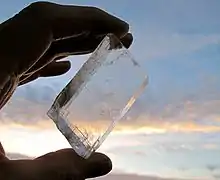Spath d'Islande
Le spath d'Islande est une variété transparente de calcite. Selon l'hypothèse de certains chercheurs, c'est un cristal de ce type qui aurait pu servir de pierre de soleil à des Vikings[1].

Un spath d'Islande.
La biréfringence de ce cristal, découverte en 1669 par Rasmus Bartholin[2], a été étudiée par Christiaan Huygens (1678), Étienne Louis Malus (1810) et William Nicol (1828).
Références
- (en) Guy Ropars, Gabriel Gorre, Albert Le Floch, Jay Enoch et Vasudevan Lakshminarayanan, « A depolarizer as a possible precise sunstone for Viking navigation by polarized skylight », Proceedings of the Royal Society A : Mathematical, Physical and Engineering Sciences, The Royal Society, vol. 468, no 2139, , p. 671-684 (lire en ligne).
- Experimenta crystalli islandici disdiaclastici quibus mira et insolita refractio detegitur, Copenhague 1669.
Cet article est issu de wikipedia. Text licence: CC BY-SA 4.0, Des conditions supplémentaires peuvent s’appliquer aux fichiers multimédias.